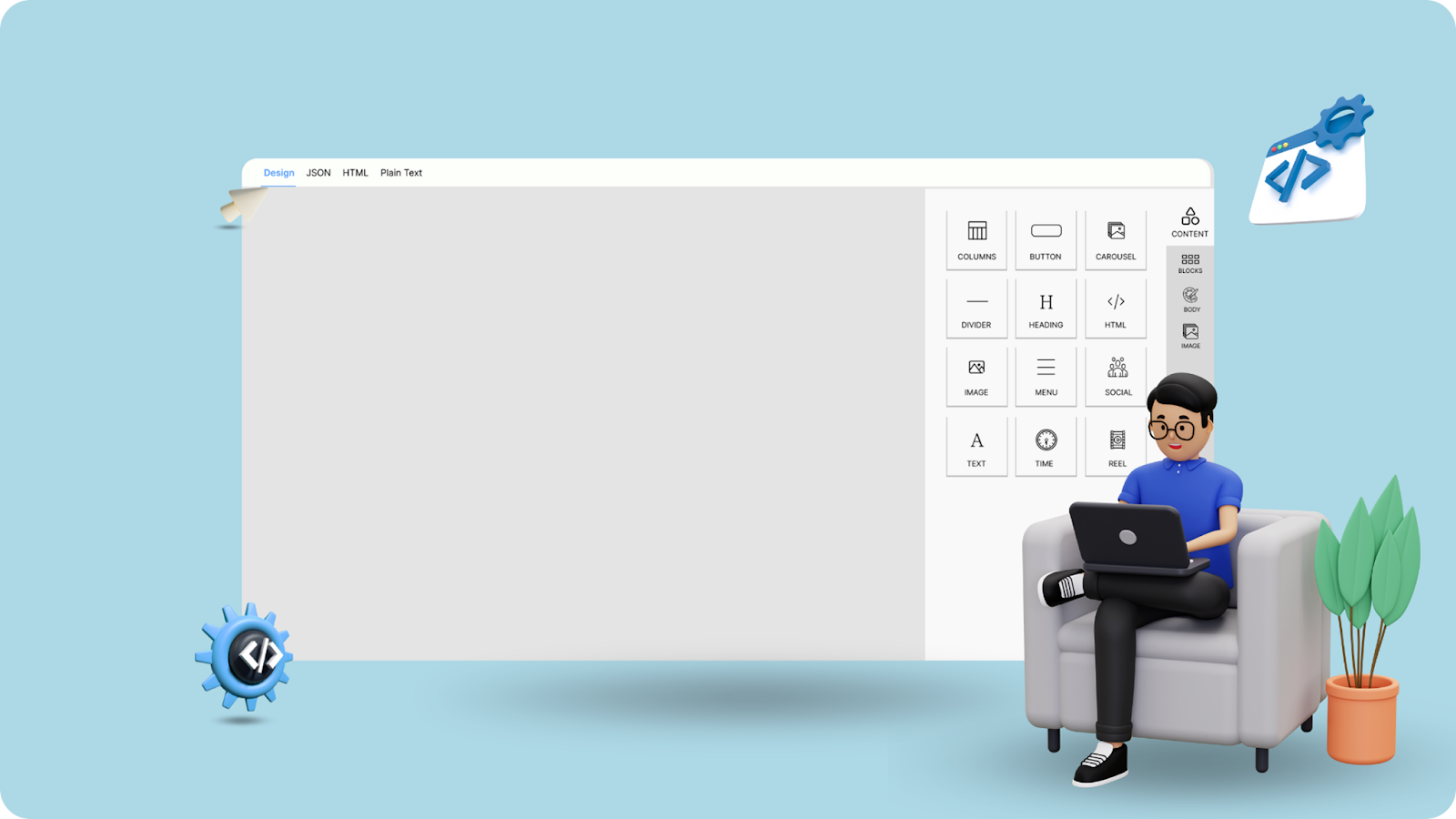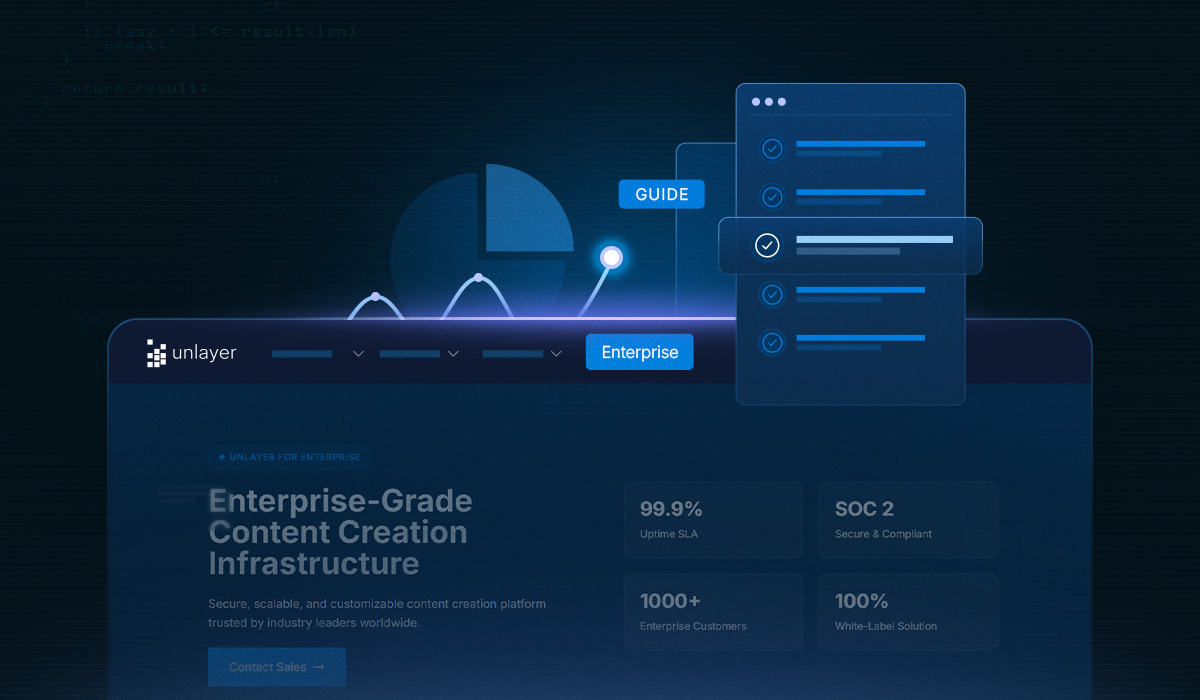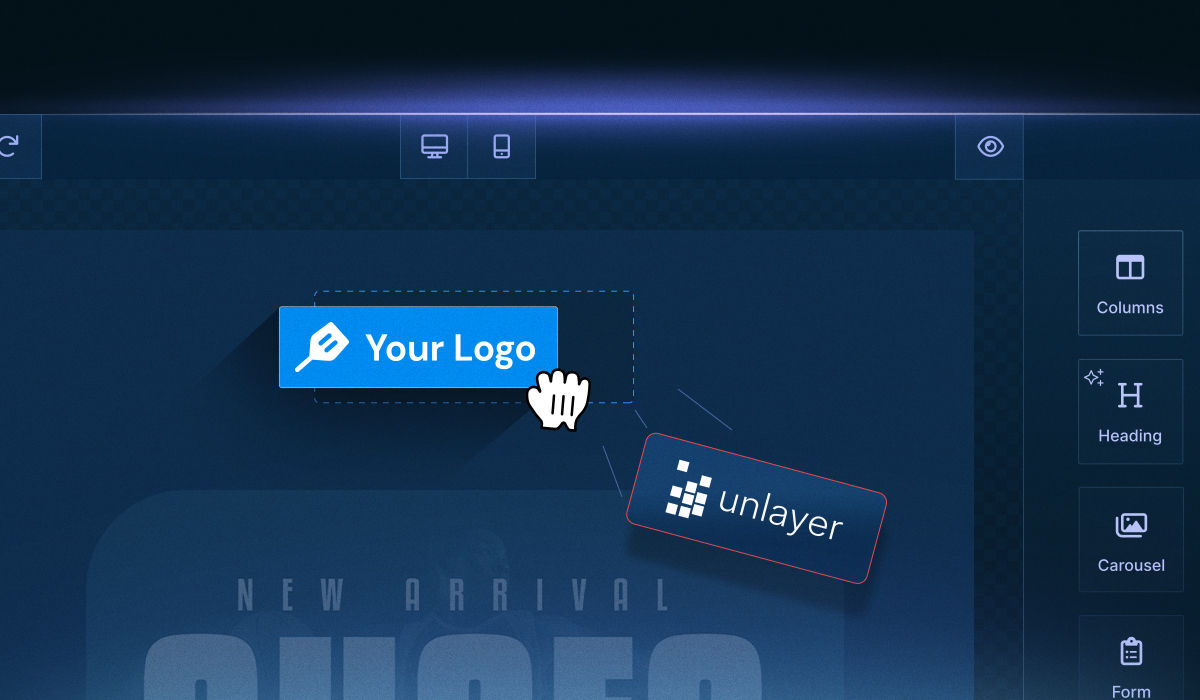Want to support AMP emails inside your product without building a custom editor? Learn how the AMP email component works inside embeddable editors and what features to look for.
The top key takeaways are:
AMP email components bring interactivity to the inbox, and embeddable editors must support them to enable seamless in-email actions.
The best AMP-compatible editors offer drag-and-drop blocks, live previews, ESP integration, and built-in validation.
Common AMP challenges like client support, formatting, and authentication are addressed with modern tooling.
This blog compares top AMP-ready editors: Unlayer, Stripo Plugin, and Beefree SDK.
Unlayer stands out as a white-labeled email builder with full AMP support, SDKs, custom blocks, and enterprise-grade reliability.
What Is AMP for Email?
AMP for email is a framework developed by Google that extends traditional HTML to enable interactive content inside emails. It relies on a multipart MIME (Multipurpose Internet Mail Extensions) structure, including text/plain, text/html, and text/x-AMP-html, and enforces strict layout, styling, and validation rules.
How do AMP emails differ from traditional HTML emails?
While both formats use HTML, AMP introduces stricter syntax, interactive components, and heightened security requirements.
Feature | Traditional HTML Emails | AMP Emails |
Interactivity | Limited (mostly links, buttons), experience often includes multiple steps and load transitions | High (carousels, accordions, live forms, dynamic email content) |
User Actions | Redirects to external sites | Handled within the email (e.g., RSVP, submit forms) |
Content Updates | Static—content is fixed once sent | Dynamic—content can update in real-time |
Supported Technologies | HTML + CSS (basic) | AMP HTML (restricted HTML subset + AMP components) |
Coding Flexibility | High, but with limited interactivity | Structured and restricted for performance & security |
Security | Depends on the sender; more open to vulnerabilities | AMP enforces strict security standards (SPF, DKIM, DMARC), reducing spoofing and abuse risks. |
Rendering Consistency | May vary across email clients | More consistent rendering in supported email clients |
Email Client Support | Universally supported | Supported by Gmail, Yahoo Mail, and Mail.ru (limited) |
Development Complexity | Simpler but less dynamic | More complex unless using AMP-compatible editors |
User Experience | Passive, click-driven | Interactive, app-like experiences inside the email |
Quick Overview of Key AMP Email Components
AMP for email includes a curated set of components designed to support interactivity within the inbox, without relying on JavaScript or external styles. These components make it possible to power forms, data rendering, and interactive content directly inside the message.
Here’s a quick overview of the most commonly used AMP components:
<amp-form>: Enables form submissions within the email
<amp-list>: Loads dynamic content from external data sources
<template type="amp-mustache">: Formats and displays the output from AMP-list or amp-form
<amp-selector>: Allows users to select multiple options inside a form
<amp-bind> and <amp-state>: Enables logic-based interactivity such as toggling, visibility, or state-driven changes
<amp-carousel>: Displays scrollable images or product sliders
<amp-accordion>: Organizes long-form content into collapsible sections
These components are fully supported in Unlayer’s email builder. Users can add AMP functionality through built-in blocks and settings, and no manual coding is required.
So, what are you waiting for?
Sign up for free and start creating interactive AMP emails today.
Understanding how AMP changes the structure of email also highlights why it’s worth implementing.
Understanding the Developer Impact of AMP Email Component

For platforms embedding email editors, AMP opens the door to real-time, form-driven, and highly personalized interactions. This means less friction for end-users and more control over the experience for developers.
Here’s what makes AMP valuable from a developer’s perspective:
Native interactivity: Build emails that function like mini web apps, no browser required.
Reduced redirects: Users can submit forms, browse products, or confirm actions directly in the message.
Customizability at the code level: Developers can tailor layouts, control logic via <amp-list> and <amp-bind>, and adapt component behavior to backend data.
However, AMP requires precision. Embedded editors must support a stricter rendering model and produce valid AMP markup. That’s why it’s best to choose editors with built-in AMP capabilities, so you can focus on creating AMP emails without dealing with complex code.
Top 5 Benefits of AMP for Embedded Email Editors
AMP email component brings tangible advantages for both developers and end-users, especially when delivered through embedded editors integrated into CRMs, marketing automation tools, or client dashboards.
Here are the core benefits for platforms building AMP support directly into their email editors:
1. Better user experience
AMP email component eliminates the need for click-through journeys by enabling interactive emails inside the inbox, such as forms, carousels, or accordions. This reduces friction, streamlines workflows, and improves user satisfaction for those who are interacting with your emails.
2. Embedded action flows
Instead of linking users out to complete tasks, the AMP email component supports form submissions, confirmations, and list selections directly inside the message. This shortens user journeys and keeps key workflows contained within the inbox.
3. Real-time content updates
With components like <amp-list> and <amp-bind>, developers can populate emails with data that updates when the email is opened. This supports use cases such as:
Current inventory availability: Show only in-stock products in real time to avoid customer frustration.
Location-specific content: Display region-based promotions, store details, or weather updates based on customer location.
Live appointment slots or product data: Let customers book appointments or view the latest prices and product status without leaving the inbox.
4. Seamless personalization
AMP email component enables developers to integrate external data endpoints directly into email content. For example, it shows a user’s most recent purchases or preferences without relying on static content generated at send time.
5. Strategic value for SaaS platforms
Using embeddable visual editors with built-in AMP capabilities can extend your product’s value proposition. It gives your users modern design capabilities while keeping content creation and delivery inside your host application, reducing dependence on third-party tools.
What to Look for in an Embedded Email Editor With AMP Capabilities
AMP email component offers new interactivity inside the inbox, but implementing it manually requires extra steps from authentication setup to validation and MIME formatting. Instead of building these layers from scratch, product teams can streamline the workflow by integrating an email editor that handles AMP automatically.
When evaluating an embedded editor for AMP compatibility, here are the capabilities that make a meaningful difference:
1. Built-in AMP support
Editors should offer native AMP support, so users don’t need to write AMP HTML, manage MIME structure, or validate markup manually. AMP output should be handled in the background and always paired with an HTML fallback version.
2. Drag-and-drop interface
Non-technical users should be able to build AMP emails through an intuitive interface. The editor should expose interactive blocks like forms, sliders, or collapsible sections without relying on custom code or developer intervention.
3. Real-time AMP preview
AMP rendering varies by client, and mistakes often go unnoticed until delivery. A built-in preview mode should allow users to test how AMP content will look across Gmail, Yahoo Mail, and other compatible inboxes before export or deployment.
4. Pre-built AMP components
Common AMP email components such as <amp-form>, <amp-carousel>, <amp-accordion>, and <amp-list> should be available as pre-configured blocks. These should follow AMP’s formatting requirements behind the scenes, reducing error risk.
5. ESP compatibility
The editor should support export or direct integration with ESPs that can deliver AMP emails correctly, such as:
SendGrid
Amazon SES
Twilio
Salesforce Marketing Cloud
Customer.io
Adobe Campaign
Klaviyo
Blueshift
Maestra (formerly Mindbox)
Without ESP compatibility, users may struggle to assemble and send valid AMP messages even if the design is correct.
6. Validation and error handling
Validation failures are a common cause of AMP rendering issues. The editor should include built-in validation with actionable error messages when components are misconfigured, markup is missing, or the MIME structure is incomplete.
By focusing on these areas, platforms can provide AMP functionality without adding friction to the content creation or delivery process, making interactive email practical for teams at any skill level.
How to Handle AMP Email Component Challenges
While AMP for Email offers powerful functionality, it introduces complexity at both the development and delivery levels. For teams embedding AMP into visual editors or SDKs, understanding the most common pitfalls and how to avoid them is key to successful implementation.

Here’s how to overcome the challenges:
1. Maintain MIME sync
AMP emails require three content parts: plain text, HTML, and AMP markup. If any version is missing or misaligned, AMP-compatible clients will ignore the AMP content.
Best Practice: Ensure your editor or API produces synchronized content across all three formats. Treat this as a standard part of the export or send workflow.
2. Handle inconsistent client support
Only a limited set of email clients (e.g., Gmail, Yahoo Mail, Mail.ru) support AMP today. Others like Outlook or Apple Mail ignore AMP entirely.
Best Practice: Always design fallback HTML versions that mirror the AMP version in layout and purpose. For embedded editors, display a preview of both side-by-side or allow switching between AMP/HTML views.
3. Manage component restrictions
AMP does not allow JavaScript, external stylesheets, or custom scripts. Every component must conform to strict layout rules, and unsupported tags will invalidate the entire email.
Best Practice: Use UI controls and tooltips inside your editor to prevent unsupported inputs. Enforce layout attributes by default for visual components like images or carousels.
4. Ensure valid sender authentication
Even a perfectly formatted AMP email won’t render if the sender’s domain is not authenticated. Gmail, Yahoo, and other clients require SPF (Sender Policy Framework), DKIM (DomainKeys Identified Mail), and DMARC (Domain-based Message Authentication, Reporting & Conformance) setup, and will ignore AMP otherwise.
Best Practice: Embed SPF/DKIM/DMARC validation checks into your platform’s send pipeline, or flag issues during testing. Consider using pre-send dashboards or delivery health tools for teams managing high-volume email.
5. Stay updated with AMP policy changes
AMP for Email is still evolving. Components are periodically updated, deprecated, or added. Inbox providers may also adjust security thresholds or whitelisting requirements over time.
Best Practice: Maintain a direct reference to the official AMP email spec and update your editor logic accordingly. Treat AMP support as a living feature, not a one-time integration.
Comparing Embedded Editors With AMP Email Component Support
Several embedded email editors now support AMP components like forms, carousels, and dynamic content. Here’s how three leading options compare:
Editor | AMP Features | Best For |
AMP-compatible blocks, white-label editor, SDKs for React/Vue/Angular, real-time preview | SaaS platforms that need fast, branded integration | |
Pre-built AMP modules (timers, carousels), HTML+AMP export | CRMs and email tools focused on interactive campaigns | |
Visual AMP editor, content blocks, localized UI, hosted setup | Teams that need a quick, backend-free AMP deployment |
Each editor streamlines the AMP email component in different ways. For teams embedding content creation into their platform, the right choice depends on branding needs, development resources, and how much AMP control you want to retain.
Skip Dev Time With Unlayer’s Amp-Ready Email Editor
Building an email editor from scratch can take months, and even then, it’s difficult to maintain feature parity, performance, and compliance. A faster approach is to embed a white-labeled builder that’s flexible, scalable, and built for SaaS.
Unlayer offers an API-first email editor designed for CRM, marketing, and internal platforms. It handles rendering, validation, customization, and export behind the scenes, so your team stays focused on your core product.
Why Unlayer:
Auto-generates fallback HTML
Real-time AMP + HTML preview
AMP validation safeguards
Export-ready AMP markup
Fully white-labeled UI
SOC 2 compliance
99.9% uptime SLA
Enterprise onboarding & support
Want interactive emails without the dev hassle? Book a Demo and see how Unlayer makes it easy.
FAQs About AMP Email Components
Got questions about AMP email components and how they work inside embedded editors? Here are clear answers to the most common ones.
1. What is an AMP email component?
An AMP email component is a predefined tag (like <amp-form> or <amp-carousel>) that adds interactivity inside the inbox. These components allow users to take actions, such as submitting forms or viewing image sliders, without leaving the email.
2. Do all email clients support AMP email components?
No. AMP components are only supported by a few email clients, including Gmail, Yahoo Mail, and Mail.ru. Others, like Apple Mail and Outlook, will ignore AMP content and display the fallback HTML version instead.
3. Is AMP for email secure?
Yes. AMP emails require domain-level authentication using SPF, DKIM, and DMARC. In addition, AMP components must follow strict formatting rules, and no custom JavaScript is allowed, making them more secure than traditional HTML emails.
4. Can I use AMP email components without writing code?
Yes, if your platform uses an embedded email editor with built-in AMP support.
Tools like Unlayer allow you to use AMP components through drag-and-drop blocks without needing to write or validate AMP code manually.





